Pandas have been around for thousands of years and have lived peacefully. But along the way, they have become endangered animals. Why are pandas endangered?
Giant Pandas are one of the most adorable animals in the world, with a distinctive black-and-white appearance. But did you know that there are less than 3,000 Giant Pandas left in the world? There are approximately 1,900 Giant Pandas in the wild and more or less 600 in zoos or breeding centers. They were classified as endangered due to their limited habitat range and low reproduction rate. In 2016, their status was changed from “Endangered” to “Vulnerable.”
The Giant Panda (Ailuropoda melanoleuca) is a mammal that can be found in Northeastern China and Southern Siberia. For many years, the low reproductive rate of the pandas has made them a “vulnerable” species on the IUCN Red List.
- Status: Vulnerable
- Known as: Giant Panda, Panda, Panda Bear
- Estimated numbers left in the wild: 1,900 (possibly as many as 3,000)
The Panda is famous around the world! It has become something of a cultural icon.
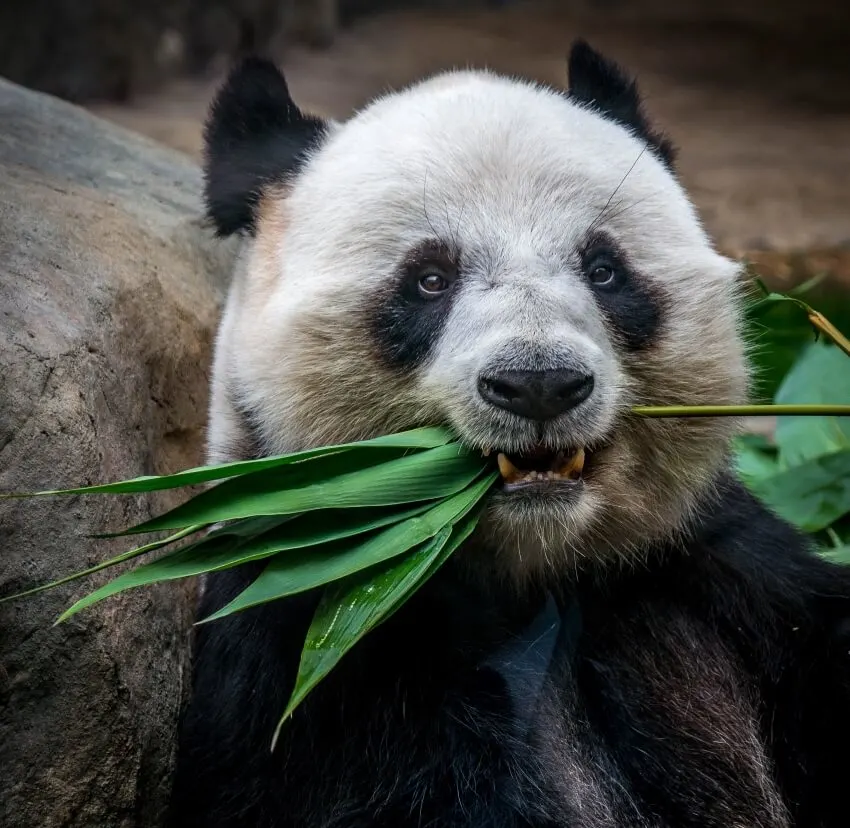
Its adorable black-and-white face and bamboo diet make it seem like it’s just begging to be saved by humans who want nothing more than to give it all the love and attention that this wonderful creature deserves. The Panda is also known as Ailuropoda melanoleuca.
This fascinating species is threatened by a number of things, chief among them being their low reproductive rate. Pandas have difficulty breeding and often give birth to only one or two cubs at a time.
| Category | Information |
|---|---|
| Common Names | Giant panda bear, Panda bear, Panda |
| Scientific Name | Ailuropoda melanoleuca |
| Conservation Status | Vulnerable (VU) according to IUCN Red List |
| Population Size | About 1,800 individuals in the wild; over 300 in breeding centers and zoos |
| Distribution/Geography | Endemic to China; mountain ranges in the central provinces of Sichuan, Shaanxi, and Gansu |
| Habitat | Montane forests and mixed forests with a thick understory of bamboo |
| Appearance | Medium to large size bear with a large head, small eyes, long muzzle, large nose, short tail, black and white fur, and a “thumb” extension of its wrist bone |
| Diet and Nutrition | Herbivorous (folivores); 99 percent bamboo, may also eat meat, fish, and eggs when available |
| Daily Bamboo Consumption | 9 to 14 kg (20 to 30 lb) of bamboo shoots |
| Social Structure | Solitary; mark territory with secretions from scent glands and scratch marks on trees |
| Activity | Terrestrial, crepuscular (active at dawn and dusk), able to climb and swim |
| Mating Habits | Polygynous; breeding between March and May |
| Gestation Period | About 5 months |
| Cubs | 1 or 2 cubs born blind and toothless, weighing 90 to 130 grams |
| Weaning | At about 1 year old; stay with their mother for an additional 6 months |
| Reproductive Maturity | Between 4 and 8 years old |
| Population Threats | Hunting for fur, habitat loss due to deforestation and land clearance, climate change affecting bamboo |
| Ecological Niche | Distribute bamboo seeds; panda-protected areas help native ecosystems |
| Cultural and Symbolic Significance | National symbol of China, symbolizes peace, featured on coins and as Olympic mascot, not used in traditional Chinese medicine |
| Interesting Facts | Good night vision like cats, low-energy lifestyle due to bamboo diet, spatial memory, black skin under black fur, pink under white fur |
| Historical Significance | Chi-Chi the Giant panda inspired the WWF logo; pandas have been on Earth for 2-3 million years |
Description
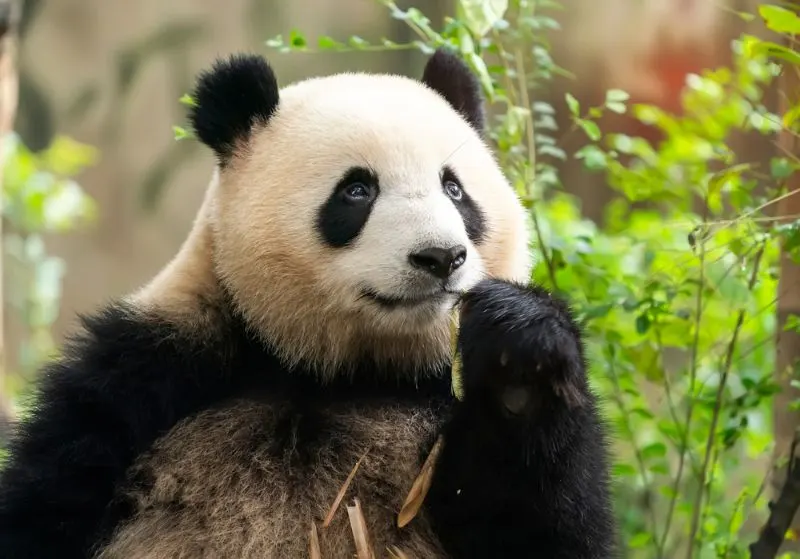
The Giant Panda is a black and white bear from China. Its unique image is perhaps the most recognizable in today’s animal kingdom. It weighs 136 kilograms and measures 1.2 to 1.5 meters long.
These solitary, territorial bears live in cool, wet bamboo-filled forests at several thousand meters and are currently confined to central China.
The giant Panda and the bamboo plant are inseparable. In fact, one of the Panda’s wrist bones has elongated to provide a sixth toe on each fore paw. The sixth toe serves as a thumb while grasping stalks of bamboo.
Due to the low nutritive value of bamboo, a panda spends around 12 hours daily eating. It consumes up to 14 kilograms of vegetation to sate its appetite. Pandas remain omnivorous and eat a few rodents and birds. But these are only occasional supplements to their daily bamboo salad.
Though pandas can climb and swim, they tend to avoid steep slopes because of the high energy demands these impose. Each Panda needs at least two bamboo species in its home range so that it does not starve when one species reaches the end of its yearly cycle and dies back.
The Panda’s rounded, friendly-looking face is due to huge jaw muscles and enlarged molars needed to grind bamboo into a digestible pulp. A wild panda usually lives for around two decades, though those in captivity can live for up to 30 years.
Though they are actual bears and display some bear-like behaviors, such as clawing the bark of trees to mark territorial boundaries, these fascinating species do not hibernate or even establish a permanent den.
In cooler months, they move lower down the slopes to areas with warmer temperatures. Hollow trees and rock crevices are both favored as temporary resting spots.
They are nocturnal, solitary creatures except during the breeding season, when they may couple for up to 24 hours a day. They typically live up to 25 years in the wild, but if born in captivity, they typically live between 30-40 years of age.
Western discovery
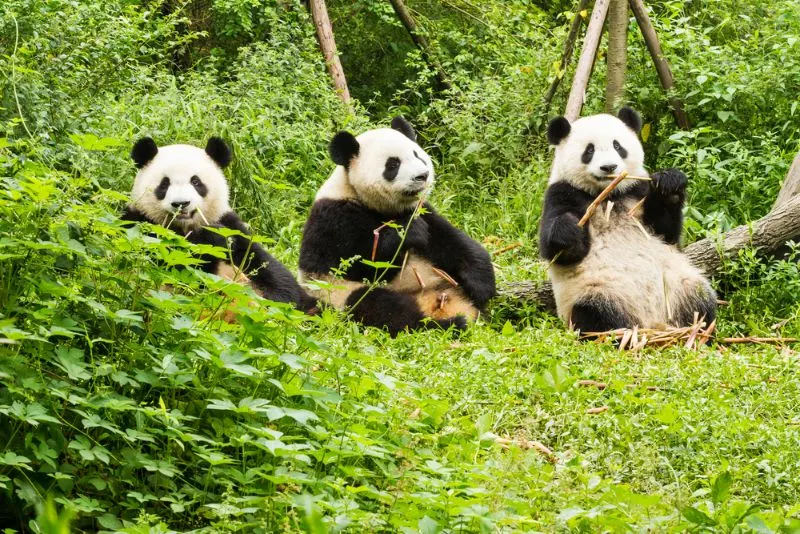
This fascinating species has been around for millennia. It wasn’t until 1869 that French missionary Armand David first discovered and documented the species as a western discovery. His work in the field is known for spotting animals such as pandas and monkeys in his native Germany, which was his first real-life encounter.
The first West Indian to kill the Pandas came during World War One when they were killed at Fort Washington. Ruth Harkness restored the original pandas to Chicago in 1936. John Tangière Smith captured five huge pandas, which were transported and put into London.
Grandma has gotten some sleep recently. A second man named Yang became the lion panda at the London Zoo. Her head is a member of the Royal Colleges of Surgeons, and her neck is being publicly displayed here.
Anatomy and Appearance
The Giant Panda is a black and white bear that has a distinctive black eye patch around its eyes.
These fascinating species have very thick fur coats that keep them warm in their cold habitats. They are the size of a large dog, and they weigh around 100-115 pounds.
Pandas have very strong jaws that help them eat bamboo stems and shoots. They have small rounded ears and a tail that is about half the length of their body.
Giant Pandas live in bamboo forests and eat mostly bamboo shoots. They are solitary animals and only come together to mate. These species have a low reproductive rate and typically give birth to one or two young cubs every two years.
They are a species of bear that is found in China and Southern Siberia. These species are notable for their black-and-white coloring.
They are monotypic species, which means that it only has one known subspecies. The Giant Panda is also the only living species in the genus Ailuropoda. Female Pandas are typically smaller than male Pandas. Panda cubs are born without fur and are completely white.
See Related: Greater Bamboo Lemur: Why Is It Endangered?
Location
The Giant Panda is found only in China in the wild. This scarce bear lives only in mountainous bamboo forests, where its favorite food is abundant.
The Panda has a wide range, but the scattered distribution of bamboo-filled forests means that few pandas live in any one place.
Giant Panda Habitat
They are found in bamboo forests at high altitudes. A giant panda’s habitat is a bamboo forest because it has all they need: food, water, and shelter. Panda reserves help secure panda populations and their habitats from danger.
They inhabit elevations of 5,000 to 10,000 feet and live in a few mountain ranges in central China. The Chengdu Plain and the Qinling Mountains are two of their major habitats. They are native to the forests of southwest China.
These species are threatened by several factors, including habitat loss, poaching, and a low reproductive rate.
Giant Panda Diet and Nutrition
The Giant Panda is a carnivore, but bamboo makes up almost its entire diet. They sometimes eat small rodents, fish, and eggs.
Giant Panda Mating Habits
This vulnerable species are known for its low reproductive rate, and while there isn’t a lot of information out there about their mating habits, we can make some guesses.
Giant Pandas are solitary animals, so it’s likely that they only come together to mate. They’re also very picky eaters, so the male and female Giant Panda may have to spend a lot of time looking for the right food before they can mate. Also, there are only a few potential mates.
They have a very low reproductive rate because the female Giant Panda only ovulates once a year, and the fertilized egg divides slowly. The female Panda gives birth after 95-160 days of pregnancy. The cubs are also very small and vulnerable at birth.
See Related: Grizzly Bear vs Black Bear: What’s the Difference?
Giant Panda Cub
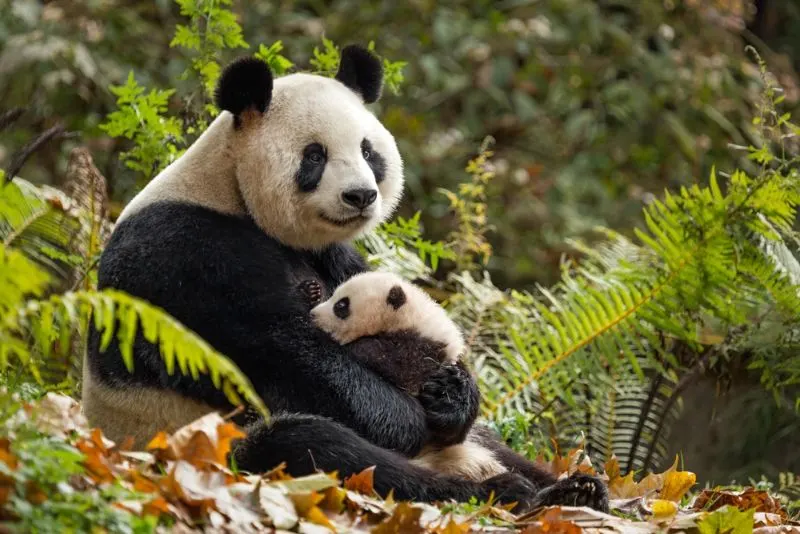
Giant Panda cubs are born blind and without fur. They nurse for up to a year and a half and stay with their mother pandas for two to three years. Panda cubs are a major tourist attraction in China.
To help conserve the Giant Panda population, the Chinese government has begun to limit the amount of Panda cubs that can be bred in captivity. This is because Panda cubs are not able to survive on their own in the wild and must be cared for by humans.
They are threatened by habitat loss and fragmentation. These fascinating species’ natural habitat has been reduced by more than 50% in the last 50 years. This is due to deforestation, development, and climate change.
Giant Panda vs Other Bears
The Giant Panda is a member of the bear family, which also includes the American Black Bear, Brown Bear, Polar Bear, and Sloth Bear.
They are less well-known than other bears. Unlike other bears, these species live in mountainous areas. Pandas spend up to 14 hours a day eating bamboo.
Giant Pandas have been living for approximately three million years. Pandas are endangered because people have killed them, and they live in small areas.
Pandas are different from other bears because these pandas are the only bears that like to eat plants. They also have a very low reproductive rate, and this is one of the reasons why pandas were endangered.
They do not normally mate until they are five years old, and Pandas only have one baby on an average of every two years.
Pandas cannot reproduce unless the Giant Panda female is in heat. They also keep their babies for around 2-3 years, which is long when compared to other bears because these species are so slow reproducing.
Giant Panda vs Red Panda vs Qinling Panda
The Giant Panda and Red Panda are often confused with one another, but they are two very different animals.
Giant pandas are bears, while red pandas are raccoons. These species are much larger than red pandas. Giant pandas live in bamboo-filled forests, while red pandas live in trees. Giant pandas eat mostly bamboo, while red pandas eat a variety of things, including bamboo.
Qinling is a large Giant Panda in central China. Giant Pandas, in contrast to Qinlings, live in the southern part of Northeastern China and Southern Siberia.
Giant Pandas also differ in appearance and diet from Qinlings. Giant Pandas like cool and humid places with long periods of snow cover, whereas Qinlings like dry areas with short snow cover. Pandas eat bamboo shoots; they eat tens of pounds of bamboo shoots per day.
These pandas can not digest cellulose like other animals. Giant Pandas make their own food by digesting the carbohydrate-rich material in their bamboo diet.
Giant Panda and Human Relationship
The Giant Panda is one of the most popular animals in the world. They’re loved for their gentle nature and big, round eyes.
Pandas have been known to humans for centuries. However, it wasn’t until 1869 that the Western world first got a glimpse of these black-and-white creatures. Charles Darwin was one of the first people to write about Pandas, describing them as “a kind of bear.”
Despite their popularity, Pandas are one of the most endangered animals in the world due to human intervention. There are only about 1,864 of these fascinating species left in the wild.
China is trying to increase the Panda population by building more reserves and sanctuaries for them, but it’s an uphill battle.
Population
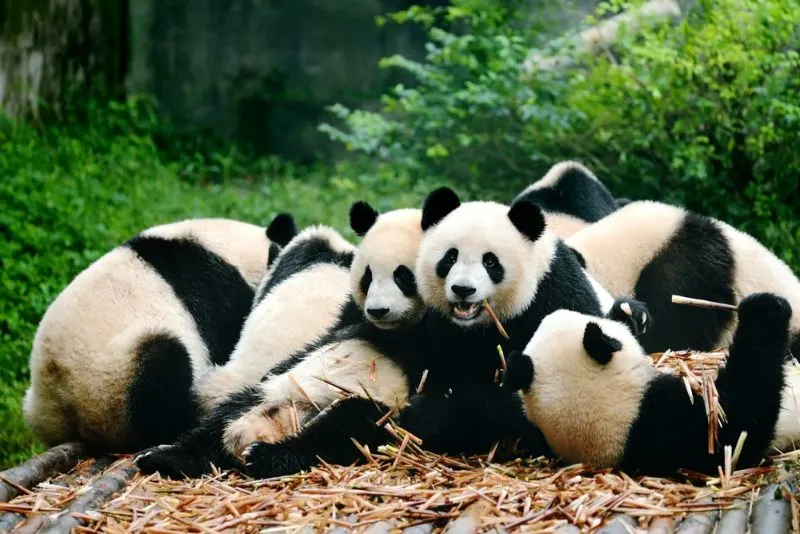
The Giant Panda has been around for centuries, and its population has fluctuated through the years. They were once widespread throughout China, being its national treasure. But, their population decreased significantly due to hunting and deforestation. They are accidentally killed or injured by snare traps while hunters aim to trap other species, like the musk deer.
These species have made a comeback in recent years. Their population is slowly increasing, but they are still considered to be vulnerable species by the IUCN. Chinese officials and conservationists breed and raise giant pandas in captivity. They will then release pandas into reserves to increase wild populations.
There are an estimated 1,864 Pandas remaining in the wild as of 2016. Habitat fragmentation, deforestation, and poaching are the main threats to their survival. Pandas are also threatened by climate change.
Role in Ecosystem
Giant pandas play a key role in the natural ecosystem. They feed on bamboo shoots that grow only in the mountain regions where Pandas live.
They are suffering from deforestation and habitat loss. These are likely to put them at risk of extinction within a few decades without any help from humans.
Predator
Predators give a big blow with one kill, considering wild panda numbers are so low. Giant Panda’s natural predators are leopards, birds of prey, and humans.
The Panda is threatened by many different predators, the most common of which are humans. Hunters kill these giants for their fur and other body parts. They use these body parts in traditional Chinese medicine. Other predators of these Panda include golden jackals and wild dogs.
Facts
Here are some interesting facts about Giant Pandas
- They are visible only for about 12-14 hours each day.
- These species spend most of their time eating bamboo shoots but also eat other things like small animals, wild fruit, roots, and grasses.
- They have a slow metabolism which is why they hibernate for up to 10 months at a time.
- They can stand on their hind legs for less than one minute before growing too tired to continue.
- They are used in gardening because they are strong enough to do some low-level work with very little effort.
- They are unique species of bears that are found in certain parts of China and Siberia.
- This species has been around for centuries. But a human first documented the Giant Panda in 1869. It was French missionary Armand David who discovered it as a western discovery.
- They are one of the most vulnerable species in the world. The Wild Giant Panda Population population is so low, but Pandas continue to flourish despite all odds.
- They have two long, sharp claws that they use for defense and to strip bamboo.
- They also have a unique thumb on each paw that has an extra bone in it. This gives Pandas the ability to grip things better than most animals.
See Related: Types of Bears From Around The World
Conservation Status

Giant Pandas were an endangered species, but now they are recategorized as vulnerable species.
Pandas are at the top of the food chain. There is not much else that can keep Giant Pandas in check, which is why pandas conservation is difficult. These species conservation requires that habitat be maintained and protected so Pandas can survive.
Giant Panda conservation also includes providing these giants with enough bamboo, so they do not need to go out looking for food. The Pandas population continues to decline due to poaching, loss of natural habitat, and low reproductive rates.
Threats
The Giant Panda is very vulnerable to modern-day threats because of its limited range, exacting dietary needs, and prolonged breeding rate. They are also threatened by poaching. Poachers kill Pandas for their fur and meat.
Habitat Loss
One of the main threats these fascinating species are facing is habitat loss. Habitat loss can come in many forms, including deforestation and reforestation. Human activity and the increasing human population are the main causes of the loss of the Giant Pandas’ habitat.
They also lose their habitat when they’re moved for breeding programs. They are especially threatened by habitat loss because they mainly eat bamboo, which is concentrated in one area of their habitat.
Habitat destruction and pollution have caused major damage to the panda population, but poaching is the most serious threat to the species. Early, ham-handed efforts at conservation also contributed to the species’ decline.
These wonderful species are found in bamboo forests high in the mountains of China, mostly in Sichuan Province.
These forests are being cleared to make way for farmland and development. Giant Pandas need a lot of space to live and roam, and with their habitat shrinking, they are forced into smaller and smaller areas.
Poaching
Poaching has been a major threat to Giant Pandas for many years.
Poachers kill Pandas for their fur and other body parts, which are then sold on the black market. Panda cubs are also sometimes kidnapped from the wild and sold as pets.
Panda pelts are naturally valuable on the black market, giving an incentive for poaching these unique animals.
Demand for these panda skin was particularly strong in Japan and Hong Kong.
Pandas are hunted more often because they are on the Chinese and Asia’s “big-five” list, which means hunters can make a lot of money from selling Giant Panda parts on the black market.
Low Reproductive Rate
The Giant Panda is one of the world’s most vulnerable creatures. One of the major reasons for this is their poor reproductive rate. These species have difficulty reproducing, and when they do, the cubs are often not able to survive.
This is due to a number of factors, including the fact that Giant Pandas are very selective about their mates and often don’t mate at all.
See Related: Conservation vs. Preservation
Conservation efforts
Conservation efforts
The Giant Panda is one of the most vulenerable animals in the world. There are many organizations and people who are dedicated to helping preserve these creatures.
Conservation efforts for Pandas include building more reserves and sanctuaries for them. It also includes increasing awareness about the plight of the Panda, and working to keep their native habitat intact.
Panda conservation is an ongoing effort. It requires the cooperation of many different people and organizations. Habitat loss is the biggest threat to the Giant pandas, so preserving their natural habitat is essential to their survival.
Deforestation and pollution are also major threats to these Pandas. Increasing awareness about these issues is also very important.
Heavy conservation efforts, including wholesale removal of humans from the Panda’s remaining panda habitat, appear to be paying off with a slowly increasing population.
There may be as many as 3,000 of these species in the wild today, and vigorous international conservation programs continue. Gun control in the regions where wild pandas are found has also proven effective at reducing the numbers that fall to poaching and other forms of illegal hunting.
Captive Breeding
Giant Panda captive breeding has been a focus of zoos and researchers for many years now.
The Panda is one of the most beloved animals in the world, and efforts have been made to keep them from going extinct.
While Pandas are found in the wild, their population has dwindled to such a point where they are considered “endangered. ” Captive breeding offers some hope for the future of the Giant Panda.
The Giant Panda Breeding and Research Center is an institution among the breeding centers located in Chengdu, China, to protect Pandas and help them increase their numbers.
These species are one of the rarest animals on earth because they can only mate once a year and have a baby every two years.
The breeding center looks for Pandas that live in the wild that need help, like pandas that may not be able to find enough food. Pandas at this center are cared for by humans, who provide them with things like bedding and food to make sure they stay alive.
See Related: Best Conservation Poster
Organizations
There are a number of organizations that help Pandas by protecting their natural habitats, promoting Giant pandas conservation, and working with pandas in captivity.
They were endangered because of many factors, including habitat destruction and fragmentation, poaching, and lack of genetic diversity. These factors threaten Giant Pandas’ future as they make it difficult for the Giant Panda to survive.
Bear Trust International

Bear Trust International is an American organization that protects different bear species around the world and their habitats through education, research, management, and habitat conservation.
It was established to help rescue these species and reduce the number of endangered species. It is one of the most successful charities in the world, which has rescued over 60 Pandas.
Hauser Bears

Hauser Bears is a UK-based charity with a mission to change people’s attitudes towards bears. Their main work revolves around research and education to ensure a future for all bear species.
PDXWildlife

PDXWidlife collaborates with local organizations on three different continents to conserve endangered species like the Giant Panda and its habitat through research and outreach programs.
PDX Wildlife is a non-profit organization that helps to rescue and rehabilitate injured and orphaned animals.
One of the main goals of PDX Wildlife is to educate the public about how to interact properly with wild animals. The organization provides information about what to do if you encounter an animal in need, as well as how to properly construct a wildlife-friendly habitat in your backyard.
World Wildlife Fund

The World Wildlife Fund (WWF) is one of the largest and most well-known conservation organizations in the world.
They work with governments and other NGOs to help protect, deter, and recover threatened wildlife populations around the world. To do this, they focus on four areas:
- Focusing on government policy and governance;
- Supporting investment for conservation;
- Ensuring sustainable livelihoods for people living in or near protected areas;
- Working with communities to manage protected areas and wildlife.
One of the main creatures that WWF helps protect is the Giant Panda.
WWF works throughout the world with governments and local communities to protect the Panda’s natural habitats. They also offer advice on how to adapt farming practices to protect wild Pandas and collaborate closely with local communities to reduce poverty and promote sustainable development.
Final Thoughts
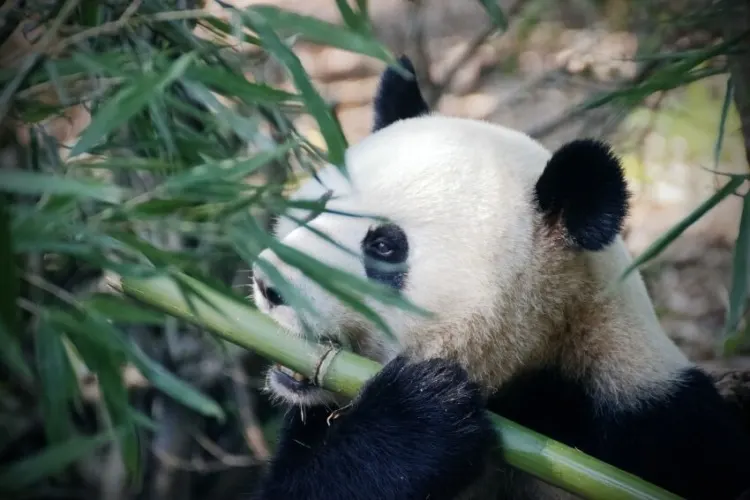
Giant Pandas are one of the most vulnerable animals in the world, but why?
Giant Pandas are found in Northeastern China and Southern Siberia. Giant Pandas have been classified as a “vulnerable” species from an IUCN Red List for many years now due to their low reproductive rate. They have a high risk of being endangered due to human activity.
Habitat destruction and pollution have caused major damage to the wild panda population, but poaching is the most serious threat to this species. Early, ham-handed efforts at conservation also contributed to its decline.
These fascinating species are very vulnerable to modern-day threats because of their limited range, exacting dietary needs, and prolonged breeding rate. Heavy conservation efforts, including wholesale removal of humans from Giant Panda habitat, seem like it’s paying off with a slowly increasing population.
FAQ
What is Giant Panda?
A giant panda is a black-and-white bear species endemic to China. Giant Pandas have been classified as a “vulnerable” species from an IUCN Red List for many years now due to their low reproductive rate.
Where do Giant Pandas live?
Giant Pandas live in Northeastern China and Southern Siberia. Giant Pandas are found mostly in Northeastern China, but an increasing number wander into other parts of the country, where they share a habitat with humans.
Why are Giant Pandas endangered?
Giant Pandas are no longer endangered. They were endangered before 2016 because human society has a negative effect on Giant Pandas. Now, Giant Panda populations have grown a little, and the International Union for Conservation of Nature (IUCN) moved this species to the Vulnerable category.
They also have a low reproductive rate, which means it would take a lot of Panda babies to help grow their population back up. Giant pandas live in off-limits areas for places like mining and timber harvesting as well as poaching.
In the 1990s, the Chinese government started making Panda preserves to provide better care for Giant Pandas and make them safer from humans.
The number of Giant Panda poachers is now declining after years of China cracking down hard on those who hunt them illegally.
Has a giant panda ever killed a human?
No, Giant Pandas are actually very sweet. There is no know incident of a Giant Panda killing a human.
They use their sharp teeth to eat bamboo, which is what Giant Pandas are made for! Giant pandas do not bother humans because they are wild animals with no natural enemies in the wild.
Who can I donate to if I want to help Giant Pandas?
There are a number of charities that help Giant Pandas, including WWF and World Wildlife Fund México, Indonesia, and China.
If you’re interested in helping other threatened animals as well as ecosystems threatened by change or wildlife trade, please consider donating to Hauser Bears, World Wildlife Fund, PDXWildlife, or a number of other charities whose work revolves around Giant Pandas and other endangered species.
Other Species Profile
Related Resources
